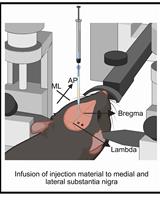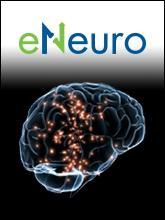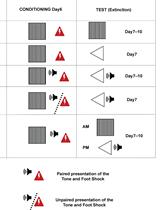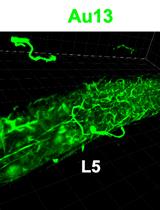- EN - English
- CN - 中文
Maternal Immune Activation with the Viral Mimetic Poly:IC in Pregnant Rats
Poly:IC模拟病毒感染对孕鼠的母体免疫激活
发布: 2020年11月20日第10卷第22期 DOI: 10.21769/BioProtoc.3817 浏览次数: 4105
评审: Vaibhav B. ShahRon Saar DoverAnonymous reviewer(s)

相关实验方案

基于 rAAV-α-Syn 与 α-Syn 预成纤维共同构建的帕金森病一体化小鼠模型
Santhosh Kumar Subramanya [...] Poonam Thakur
2025年12月05日 1395 阅读
Abstract
Maternal immune activation (MIA) is increasingly well appreciated as an environmental risk factor for some psychiatric disorders. Administration of proinflammatory compounds such as the synthetic double-stranded RNA molecule polyinosinic-polycytidylic acid (polyI:C) to pregnant rodents results in the release of proinflammatory cytokines in the maternal circulation. Various behavioural and brain changes are produced in the offspring that are associated with psychiatric disorders such as autism and schizophrenia. This protocol describes the steps necessary for inducing MIA in pregnant rat dams, which will allow for investigations into the mechanisms in the dam and offspring that mediate the long-term effects of exposure to inflammation while in utero. Increasing our understanding of these mechanisms may provide new insights for the diagnosis, treatment, and prevention of psychiatric disorders. This protocol has been developed and improved over the years by various researchers in Dr. Howland’s laboratory at the University of Saskatchewan.
Keywords: Psychiatric illness (精神病)Background
Epidemiological studies provide substantial evidence for an association between prenatal infections and increased risk for the development of some neuropsychiatric disorders, such as schizophrenia and autism, in the offspring (Brown and Meyer, 2018). Indeed, inflammation in pregnancy may alter normal development of the fetus thereby increasing the risk of the emergence of psychopathologies. Accurate identification of the mechanisms underlying these effects may advise early interventions. As a result, a number of research groups have developed models of MIA in rodents and non-human primates that offer a fruitful opportunity to examine the complex etiology of complex psychiatric disorders. Researchers have used these models to assess behavioural, pharmacological, and pathophysiological outcomes of MIA in the offspring (for reviews of this literature, see: Piontkewitz et al., 2012; Reisinger et al., 2015; Estes and McAllister, 2016; Careaga et al., 2017; Brown and Meyer, 2018; Bergdolt and Dunaevsky, 2019; Gumusoglu and Stevens, 2019; Kentner et al., 2019; Meyer, 2019). The protocol we describe below is adapted from Lins et al. (2018 and 2019) with some changes including our protocol for in-house timed pregnant breeding of rats. The use of a viral mimetic instead of infection with a virus is advantageous as the duration of the effect is better controlled and biosafety concerns are reduced. Some studies have shown similar effects on the offspring following inoculation of pregnant mice with the influenza virus thereby supporting the validity of the polyI:C model (Shi et al., 2003).
Materials and Reagents
25 Gauge needles (BD PrecisionGlideTM needle, catalog number: 14-826AA )
Antiseptic isopropyl alcohol pad, sterile, medium (Alliance®, catalog number: 211-MM-05507 )
Syringes (3 ml) (BD, Luer-LokTM Tip, catalog number: B309657 )
Virgin female Sprague-Dawley rats
Male Sprague-Dawley rats
Poly:IC HMW (InvivoGen, Catalog code: tlrl-pic-5 )
Vaseline (Vaseline® Petroleum Jelly Original)
Sterile normal saline (0.9%) (Hospira®)
Equipment
Pipette 200 μl (Eppendorf Research® plus, catalog number: 3124000083 )
Heating pads (Sunbeam®, Standard size, catalog number: 730AO-CAD-MASTER )
Beaker flask (300 ml)
Scale suitable for weighing rats
Thermometer
Rodent rectal temperature probe (Physitemp, model: BAT-12 )
Hot plate (Thermolyne, Nuova II )
Isofluorane machine suitable for rats (ARVS)
Fume hood (Hamilton, SafeAire II, model: HMLAB027 )
Light microscope (Boreal 2 Digital Compound Microscopes–HM Series)
Procedure
文章信息
版权信息
© 2020 The Authors; exclusive licensee Bio-protocol LLC.
如何引用
Readers should cite both the Bio-protocol article and the original research article where this protocol was used:
- Sandini, T. M., Greba, Q., Lins, B. R. and Howland, J. G. (2020). Maternal Immune Activation with the Viral Mimetic Poly:IC in Pregnant Rats. Bio-protocol 10(22): e3817. DOI: 10.21769/BioProtoc.3817.
- Lins, B. R., Marks, W. N., Zabder, N. K., Greba, Q. and Howland, J. G. (2019). Maternal immune activation during pregnancy alters the behavior profile of female offspring of Sprague Dawley rats. eNeuro 6(2). pii: ENEURO.0437-18.
分类
免疫学 > 动物模型 > 大鼠
神经科学 > 神经系统疾病 > 动物模型
您对这篇实验方法有问题吗?
在此处发布您的问题,我们将邀请本文作者来回答。同时,我们会将您的问题发布到Bio-protocol Exchange,以便寻求社区成员的帮助。
Share
Bluesky
X
Copy link











